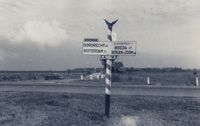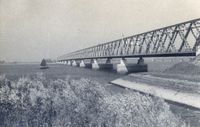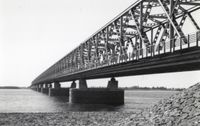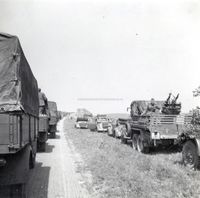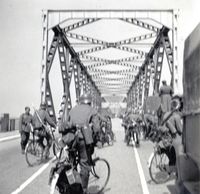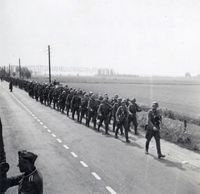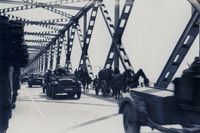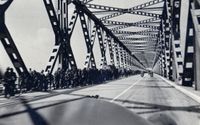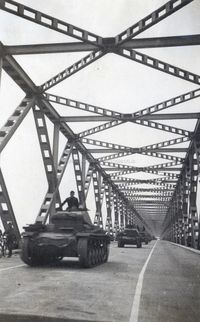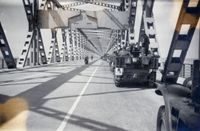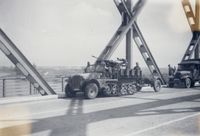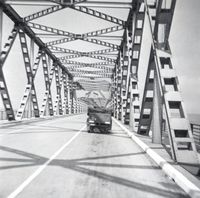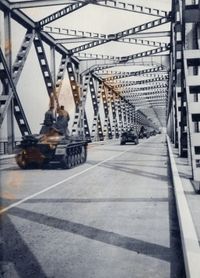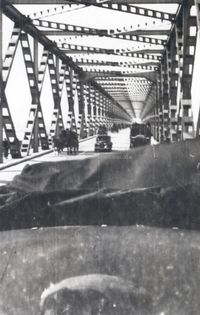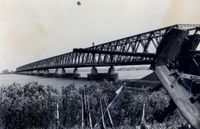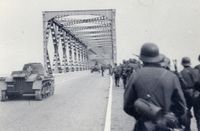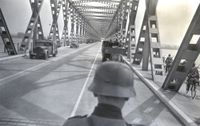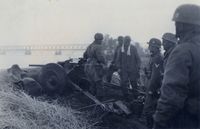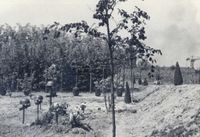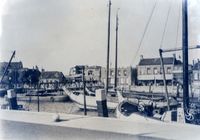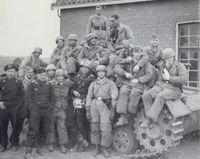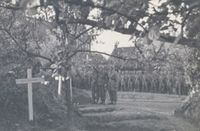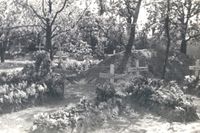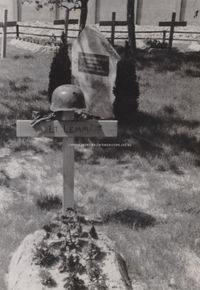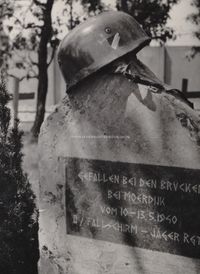Moerdijk bridges - May 1940.
On this page you will find original photographic material of the Moerdijk bridges in May 1940.
During the May days, the Moerdijk bridges were of vital importance to the German war plans. The German army, which had crossed the Dutch borders, could advance through these bridges towards Rotterdam and The Hague, thus deciding the battle for the Netherlands. Although the Dutch army had taken this into account, the defense on May 10, 1940, was lacking. The paratroopers quickly overwhelmed the bridgehead and captured the bridges. Dutch forces were unable to recapture the bridges. However, the bridgehead was regularly targeted by Dutch artillery fire. On May 12, the vanguard of the 9th Panzer Division arrived at the bridges to relieve the German paratroopers who had been defending the bridges for two days. The main force with tanks arrived on the 13th and advanced towards the Tweede Tol, engaging Dutch troops in the city center and then moving on to Rotterdam. From that moment on, the Germans were able to use the bridges to direct large amounts of troops to Holland and to Belgium and France.
These photos depict units of the 9th Panzer Division and supporting troops during May 1940 when large numbers of German units utilized the Moerdijk Bridges to advance further into the Vesting-Holland. We can see Panzer II tanks in column formation crossing the bridge. There are also various SDKFZ half-track vehicles with light FLAK cannons mounted on them. The other vehicles, such as the Red Cross vehicle, likely belong to the support units of the 9th Panzer Division. Lastly, there are two photos showing German troops crossing the bridge by horse and wagon.
Below we see two more photos of the Moerdijk bridges during May 1940. The first shot is a photo of the traffic bridge, with a German 3.7 cm Flak anti-aircraft cannon positioned on the left. The bridge was of great importance to the German advancement through the Netherlands and therefore needed to be well protected, also against aerial attacks. The subsequent photo once again showcases large numbers of German troops crossing the traffic bridge. There are German tanks of the Panzer I type, a few Germans on bicycles, and infantry units. The photo was likely taken on May 14th or 15th.
Below are two photos depicting German troop movements across the Moerdijk traffic bridge. These photos were likely taken in May 1940 when large German military units were crossing the bridge. The first photo shows horses with wagons, with what appears to be a field kitchen at the very back. These are most likely support units, known as Tross, providing aid to the troops. The second photo shows troops moving in both directions. Prominently featured is the typical German stahlhelm facing towards the truck with anti-tank artillery. To the right of the bridge pillars, there are also German soldiers on bicycles. Both photos demonstrate that not all German units were fully motorized, and that a significant amount of transportation was still carried out using horses, wagons, and bicycles.
The two photos below are very interesting. They depict German paratroopers at the Moerdijk bridges in May 1940. The first photo shows a 3.7 cm PAK (Panzerabwehrkanone) on the bank near the Moerdijk bridges. With the Moerdijk traffic bridge clearly visible on the right side, this is the Willemsdorp side of the bridgehead. The PAK gun was likely directed to reinforce the bridgehead in Moerdijk from Waalhaven on the night of May 11th to 12th.*1 The following photo is also intriguing. A paratrooper leans against the vehicle of Oberleutnant Schramm, which in the night of May 10th to 11th, collided at full speed with a barrier near the traffic bridge. Oberleutnant Schramm was on his way from Waalhaven to Willemsdorp with four pieces of 7.5 cm Skoda mountain artillery. Two of them were left behind at the Zwijndrechtse bridges. The remaining two drove onwards to Willemsdorp. Dutch soldiers had erected these barriers against the landing paratroopers. Subsequently, one of the vehicles drove into the barrier at night. Kurt Schulze, Oberleutnant Schramm's orderly, was killed in action, while Schramm himself was wounded and cared for at the Berkenhoeve. In the two subsequent photos, we also see German soldiers near the vehicle.
The village of Moerdijk and its surroundings.
The photo below shows three field graves of German paratroopers, identifiable by their distinct paratroopers helmets. In the background, we can see a large ship crane, presumably belonging to the port of Moerdijk. The presence of flowers and the well-maintained nature of the graves suggest that the photo was taken several days after the battle. The back of the photo reads: "Heldengraber von gefallenen Fallschirmjäger in Moerdijk- (Holland)". It is possible that the photo was taken in the monastery garden where multiple German paratrooper graves were located. The following photo depicts graves that were certainly in the Kloostertuin. Slightly to the right of the center, there is a memorial stone for the II Battalion of Fallschirmjäger Regiment 1. These graves were later transferred to the General Cemetery in Dordrecht.
Next, there is a photo of a German soldier in the port of Moerdijk. On the right side of him, a damaged house facade can be seen, most likely as a result of the fighting during May 1940. The subsequent photo shows a similar view from a different angle. It is still evident that two buildings in the background have war damage stemming from May 1940. Then, there is a photo of paratroopers from Fallschirmjäger Regiment 1. The photo was likely taken on May 13th, 1940. A day earlier, the 9th Panzer Division joined forces with the paratroopers at Moerdijk.
In the photos below, the commander of the II battalion of Fallschirmjäger 1 can be seen. It is Hauptmann Fritz Prager paying a final tribute at the field graves of fallen German paratroopers in the monastery garden of Moerdijk. Hauptmann Prager was injured during the battles for the Moerdijk bridges and is thus supported by two other German paratroopers. In the left corner, the grave of Jäger Otto Ehrhardt 5./FJR 1 (here in the rank of Gefreiter) can be seen, who died on May 10, 1940, in the fighting in Willemsdorp. In the subsequent photo, we see several field graves of German paratroopers in the monastery garden. From left to right (as far as readable):
- Leutnant Dietrich Lemm 7./FJR 1 - killed on May 10, 1940, on the Steenweg in Moerdijk.
- Feldwebel Hans Sohr 5./FJR 1 - killed on May 10, 1940, in Willemsdorp.
- Feldwebel Hans Fugmann 5./FJR 1 - killed on May 10, 1940, in Willemsdorp.
- (Presumably:) Unteroffzier Clerk 6./FJR 1 - killed on May 10, 1940, in Willemsdorp.
The two photos below were also taken in the monastery garden of Moerdijk. In the first photo, you can see the grave of Leutnant Dietrich Lemm from 7./FJR1. He was killed on May 10, 1940, in Moerdijk, near the Marechaussee barracks, by a gunshot to the head. In this photo, you can still clearly see the exit hole in the helmet, hanging on top of the cross. In the second photo, we see the memorial stone for the fallen paratroopers of the 2nd Battalion, which was initially placed in the monastery garden. At a later stage, both the German war graves and the memorial stone were moved to the Algemene Begraafplaats in Dordrecht.(General Cemetery).
The photo below shows the quarters of German paratroopers between Moerdijk and Lage Zwaluwe in May 1940. The paratrooper wearing a helmet is also carrying a captured Dutch Hembrug carbine. The photo was likely taken sometime between May 10 and 15, 1940. In the background, we see the train wagons, which is an indication that this photo was taken near Lage Zwaluwe.
Here are three photos of the village of Moerdijk. In the first photo, we see the port of Moerdijk. On the left is the damaged house that can also be seen in the other photos. The house was damaged during the battles over the port.
©2017-2025 :Https://www.Dordrechtindeoorlog.nl: ( There is a copyright on the content of this website. This content is not to be shared, duplicated or published withouth the explicit permission of the author of this website. If you have any requests you can email to: Info@Dordrechtindeoorlog.nl or look on : www.dordrechtindeoorlog.nl/termsofuseforthecontentonthiswebsite.
*1 Source: Zuidfront-Holland1940-Bruggenhoofd Moerdijk 12 mei - Het bruggenhoofd der para's.
*2 Source:Zuidfront-Holland1940- Wieldrecht 1e fase 11 mei - De status quo rond 04:00 uur.
